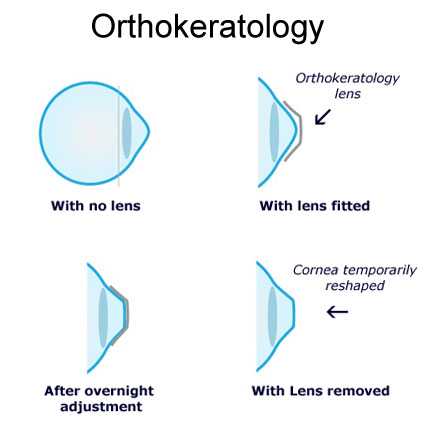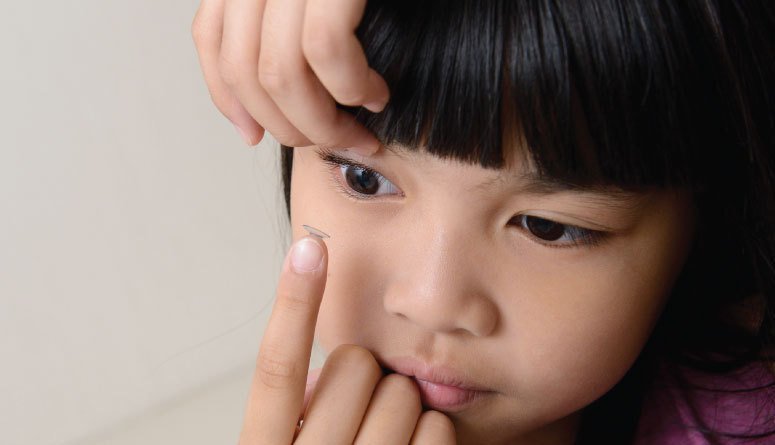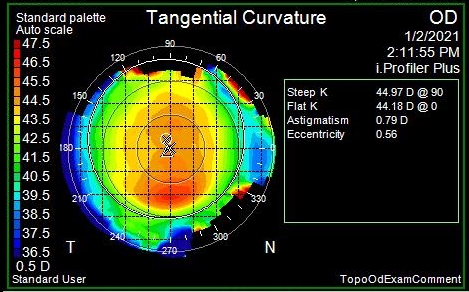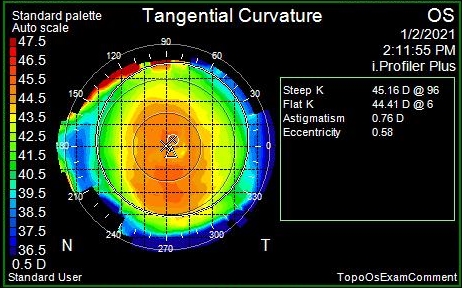Ortho-K Review
At Evershine Optical, Ortho-K is available for the control of myopia for children. Based on our short Ortho-K review, we found that our patient did not have an increase in myopia for 1.5 years and majority can adapt and handle Ortho-K lenses within a week. In this article, we will look at some of the cases that we have fitted and answer some frequently asked questions.

Ortho-K Review 1
Can Ortho-K control myopia progression?
Yes, it can. Studies have shown that the effectiveness of Ortho k in controlling myopia progression is up to about 50%.
How does Ortho-K control myopia progression
Ortho-K induces peripheral myopic defocus. This will cause peripheral hyperopic blur which leads to decreased stimulus for eye growth, thus halting myopia progression.
We have young patient who undergo Ortho-K treatment for 1.5 years. The table below shows his myopia progression since he was 6 years old.

He first started wearing glasses when he was 6 years old with myopia of -1.25 on the right and -1.00 on the left. As shown in the graph above, his myopia progressed the fastest (increment of -1.25D) when he was 7 to 8 years old. Many studies have also shown that myopia progression is the fastest at 7-8 years old. With the huge increment in myopia, ZEISS MyoVision, a myopia control lens, was recommended to slow down his progression. However, it only managed to slow down his myopia progression for a year and by the time he was 11 years old, his myopia had reached -5.50 on both eyes.
If his parents had started him on myopia control straight away instead of monitoring his myopia progression, his myopia may not have reached -5.50 by the time he was 11 years old. Hence, it is important to start myopia control early once your child is myopic to allow your child’s final myopia in the future to be lower.
To slow down his myopia progression, our optometrist recommended Ortho-K treatment since myopia control lens did not work well for him at that period of time.
When he first started Ortho-K treatment, it took less than a week for the Ortho-K lenses to reshape his cornea and he was able to enjoy clear vision without his glasses. Initially, he would get confused which lens is for which eye even after reminders from our optometrist. Under the patient guidance of our optometrist, he later was able to differentiate between left and right lenses.
Most importantly, during the Ortho-K treatment (1.5 years), his myopia did not increase.
Is Ortho-K a reversible process?
Yes, it is a reversible process. Recently, at 13 years old, he decided to return to glasses.
The image below his curvature map of his right eye before and after he stopped wearing Ortho-K lens.

Before he stopped wearing Ortho-K lens, there is a red ring, known as Bull’s Eye Pattern, on his curvature map. This is a sign whereby patient’s cornea is reshaped and Ortho-K lens sits well on his eyes.
After he stopped wearing the lens for about a week, the Bull’s Eye Pattern was not longer very obvious, This shows that the cornea is slowly going back to it’s original shape.
After about 2 weeks, the pattern could not longer be seen. This shows that the cornea is either almost or back to it’s original shape.
We followed up with him another 2 weeks later to check his curvature map and it was pretty much the same.
After ensuring that his eye is back to the original shape, we prescribed him spectacle.
We recommended Hoya MiYOSMART because it had the highest effectiveness in controlling myopia progression for spectacle lenses during that time. Our optometrists will continue to monitor his myopia progression after he switch to MiYOSMART.

Ortho-K Review 2 – How to know if Ortho-K is working
This 13 year old patient first started wearing glasses when he was 10 years old. 2 years later, his myopia increased by -1.00 on right and -2.25 on left. We explained and recommended Ortho-K to his parents and both parents and son are interested to try Ortho-K because of the benefits Ortho-K can bring.
The pictures below show the curvature map of the eye before the patient wore Ortho-K:


After his first overnight Ortho-K lens wear, he can already see well without his glasses. His right eye was fully reshaped after one night of lens wear. On the other hand, his left eye which has higher myopia was not fully reshaped yet.
We gave him soft contact lenses to wear on his left eye. However, he did not use it because he finds the vision clear enough for his daily activities.
The pictures below show the curvature map of the eye after the patient wore Ortho-K for a night:


As shown in the pictures above, there is a red ring on each eye and the one on the right eye is more prominent. Before he starts wearing Ortho-K lenses, there was no red ring on his curvature map. This red ring, also known as Bull’s Eye Pattern, shows that the Ortho-K lens is sitting well on the patient’s eye. The bull’s eye pattern was not very obvious on the left eye and this shows that the eye was not fully reshaped.
After a week of Ortho-K lens wear, his left eye was also fully reshaped.
The pictures below shows the curvature map of the eye after the patient wore Ortho-K for a week:


From the pictures above we can tell that the bull’s eye pattern on the left eye is more obvious after a week. By a week of lens wear, even the left eye is fully reshaped.
Initially when he first started wearing Ortho-K, he experience lens awareness when he open his eyes and needed more time to insert and remove the Ortho-K lenses. Within a week, he finds the Ortho-K lenses comfortable to wear and easier to handle.
So far during his follow-up session, his eye health and vision are good. He finds his vision clear even towards the end of the day and prefer Ortho-K over his glasses, especially for his sports activities.
Ortho Review 3 – Is it always clear after wearing Ortho-K?
This depends on many factors such as astigmatism, eye health and more.
We have a young patient aged 9 whose parents are interested in getting Ortho-K for him. He has myopia of about -1.00 and astigmatism of -0.50 on both eyes.
However, when we analyzed the curvature map of his eyes, we found that his actual astigmatism (cornea astigmatism + lens astigmatism) is -2.00 on both eyes.
Usually most astigmatism comes from the cornea. In this case, there is about -1.50 lens astigmatism, which is more than his cornea astigmatism. When the Ortho-K lenses reshaped the cornea and correct for cornea astigmatism, the lens astigmatism stays uncorrected. This may cause blurriness even after the cornea is fully reshaped and patient may need spectacle / contact lens to correct for the lens astigmatism.
The image below shows vision with astigmatism vs normal vision:

After advising the parents the possible outcomes, they still want to let their child try Ortho-K.
Fortunately, after his cornea is reshaped, his vision was good and the remaining astigmatism was only -0.50 on both eyes. Hence, he will not need glasses to correct his astigmatism unless he wants to see very small words far ahead.
For this patient, he was really afraid of putting the lens into his eyes. His parents had to help him open his eyes, insert and remove the lens for him. According to his mother, for the first few days, the process would take about an hour. After a week, the child got used to the lenses and the process shortened to 30 minutes. Within a month of lens wear, it takes less than 5 minutes. Children usually adapt to new things quickly, therefore wearing the Ortho-K lenses more allows them to get used to it faster.
Ortho-K Review 4 – can you wear Ortho-K on just one eye?
Yes you can. We have a few patients who only wear Ortho-K on one eye. One of them is a 10 years old girl who only had myopia on her left eye. She is engaged in many sports such as swimming, gymming and tennis. Hence, her parents preferred contact lens than spectacle for her as they find it inconvenient to use spectacle for sports.
Her right eye did not require any prescription and left eye has myopia of -1.50. We fitted her left eye with Ortho-K and she was satisfied with her vision during the day time .

Is Ortho-K worth it?
Ortho-K is slightly more expensive than myopia control lenses such as Hoya MiYOSMART, Essilor Stellest. However, it brings more convenience to your child as compared to glasses, especially if your child is active. The cost of Ortho-K varies depending on the astigmatism and curvature of your child’s eyes. Under Evershine Optical Myopia Management Program, we provide follow-up eye checks after 1 day, 1 week, 1 month and subsequently every 3-6 months. These follow-up sessions are worth up to $300, which are included in the price of the Ortho-K lenses.
To understand more about Ortho-K treatment process, click here.
Book an appointment or WhatsApp +6588461234 us to find out if your child is suitable for Ortho-K.
References
- Overnight Orthokeratology for Myopia: What Does the Evidence Say? 2019. Review of Myopia Management

